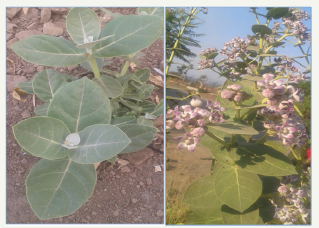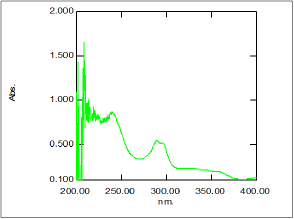- Submissions

Full Text
Advances in Complementary &Alternative Medicine
Study of Methanolic Extract of Leaves Calotropis gigantea (L.) As an Anti-Solar
Gharge Varsha Gajanan* and Yadav Adhikrao
Department of Pharmaceutics, Gourishankar Institute of Pharmaceutical Education & Research, India
*Corresponding author: Gharge Varsha Gajanan, Research Scholar, Department of Pharmaceutics, Gourishankar Institute of Pharmaceutical Education & Research, Survey No. 990, Near NH4 Highway, Limb Satara, Maharashtra 415020, India
Submission: December 08, 2017; Published: February 26, 2018

ISSN: 2637-7802Volume1 Issue4
Abstract
Objective: The present study aimed at the phytochemical examination and anti-solar activity of Calotropis gigantea L. (leaf) methonolic extract has more flavonoid content based on this chemical substance photo protective activity was evaluated using UV visible spectrophotometry, where the method is diffused transmittance and the range of UV-visible about 200-400nm.
Methods: The pulverized dried Calotropis gigantea L. leaves were extracted with Methanol using soxhlet apparatus. Methanol extract were filtered & evaporated to dryness. The photo protective activity was evaluated by using UV visible spectrophotometry, where the method it is diffused transmittance and the range of UV-visible about 200-400nm for absorption.
Results: The UV scanning absorption spectra of the extract showed very strong absorption at 0.273A with max at 397nm.
Conclusion: The extract has an ability to absorb in the entire UV range.
Keywords: Calotropis gigantea L.; Soxhlet apparatus; Methanolic extract; UV radiation; Anti-solar
Introduction
Many of the exposure of skin to sunlight is enjoyable, excessive will effective ones through both heat and ultraviolet radiation (UV) it generates. UV radiation which has a short wavelength than visible light is responsible for harmful effects like blistering sunburn and long term problems like photo-carcinogenesis, photo aging and photosensitivity. To avoid these harmful effects, there are many of the products one it known as sunscreens. Sunscreens are chemicals which absorb sun's ultraviolet (UV) radiation on the skin exposed to sunlight and prevent the UV radiation from reaching in to the skin [1,2]. There are sunscreens which absorb following different types of UV radiation such as UV-A (320-400nm), UV-B (290320nm), UV-C (100-290nm) and Vacuo UV (10-100nm) [3,4]. The use synthetic sunscreens as photo protective's restricted their use at cellular level and this limited use is because of their potential toxicity in humans and ability to interfere only in selected pathways of the multistage process of carcinogenesis. These rays have a lower energy level and a longer wavelength than UV-C. Their energy is not sufficient to split an ozone molecule; hence some of them extend down to the earth's surface. UV-A (315-400) rays do not have enough energy to break apart the bonds of the ozone, so UV-A rays passes the earth's atmosphere almost unfiltered and causes cancer. The ozone layer depletion decreases our atmospheres natural protection from the sun's harmful ultraviolet radiation. The UV radiation causes skin cancer, premature aging, cataracts and other eye damage, immune system suppression. As both UV-B and UV-A can be detrimental to our health, it is important that we protect ourselves. This can be done through a variety of ways. The sun protection products including sunscreen creams and lotions are available in the market to absorb or reflect the sun's UV radiation to protect the skin for such damages. The natural substances like anthraquinones, flavonoids and polyphenols have been considered as sunscreen agents because of their ultra violet radiation absorption [5] and antioxidant activities [6] various herbal formulations and chemicals are available to block UV rays and always prevent all types of skin from various types of damages. Our objective is to find out such leaves that are widely used as sunscreen from ancient time. Calotropis gigantea L. is a traditional medicinal plant it belongs to the family of Asclepiadaceous [7,8] are widely distribute in Asia and Africa [9-11] Asian countries that includes India, Indonesia, Malaysia, Thailand, Srilanka and China. It is commonly known as milkweed and laticiferous shrub [11]. The plant grows up to 2-4.3 meters long. It has oral, light green leaves and milky stem. The leaves are very much succulent in nature. [12] Plants contain many biologically active molecules with different medicinal properties [13,14]. It is popularly known because it produces large quantity of latex and known as milkweed or swallowwort. Latexes are source of various biologically active compounds, including glycosides, tannins and many proteins, among others [15,16]. Humankind first utilized materials found in environment an empirical basis to cure various ailments. Natural products from plants and animals traditionally have provided the pharmaceutical industry with one of its important sources of lead compounds in search of new drugs and medicines. The search for new pharmacologically active agents from natural resources such as plants, animals and microbes led to discovery of many clinically useful drugs [17,18].
Materials and Methods
Collection and identification
The plant material Calotropis gigantea L were collected from the Satara district, Maharashtra, during the month of July in the year 2016 and authenticated by Dept. of Botany, Y.C.I.S, Satara, Maharashtra, India.
Extraction
Figure 1: Whole plant of Calotropis gigantea L.

The pulverized dried Calotropis gigantea L leaves were extracted with methanol using soxhlet apparatus Figure 1. Methanol extract were filtered & evaporated to dryness [19-23]
Photochemical examination
The general flavonoid identification tests were performed on the extract.
Test 1: To dry extract, add 5ml of 95% ethanol, few drop of concentrated hydrochloric acid and 0.5g of magnesium turning. The finally pink color observed. (Shinoda test)
Test 2: To a small quantity of extract, add lead acetate solution, it shows yellow colored precipitate is formed.
Preparation of sample
The sample preparations were carried out by 10\mg % w/v concentration dissolving into the 100ml of distilled water (10mg/100ml).
Evaluation of anti-solar activity
The UV absorption spectrum for extract was obtained in range of 200-400nm using Double beam UV-Visible Spectrophotometer Model shimadzu-1700
Result
Figure 2: Following figure indicate computerized display reading of absorption spectra of the extract which is directly taken from spectrophotometer

The UV scanning absorption spectra of the Methanolic extract showed very strong absorption at 0.273A with max at 397nm. The graph Figure 2 extract also showed a plateau in range of 300400nm with moderate absorbance of ~0.3-0.1.
Discussion
The result obtained were showed the ability of extract to absorb UV radiation and hence proved its UV protection ability. The extract showed a prominent absorbance at 200-240nm, while good absorbance at a range of 240-325nm. The moderate absorbance was noted at the range of 320-400nm. Qualitative investigation indicated the presence of flavonoids in the extract. Flavonoids are the coloured pigments mainly found in leaves and flowers amongst the natural sources. They are well known for their attractive colors and pharmacological activities. It also absorbs light and helps to protect the photosensitive substances in the flower and leaves and thus play a key role in the defense mechanism of plants. Absorption of UV radiation is a main characteristic for identification of flavonoids in natural sources. The results showed strong-to- moderate absorption of UV radiation along the whole range and this ability may be due to the presence of flavonoids.
Conclusion
The extract has an ability to absorb in the entire UV range. This property to absorb in the entire UV range can be utilized for the methanolic extract to be considered as a proper wide spectrum sunscreen and also in anti-ageing cream preparation, which would be a better, cheaper and safe alternative to harmful chemical sunscreens used in modern day industry.
Acknowledgement
I solicit my deep sense of appreciation and love to my wonderful Mother & Father consider my self-privilege to have seen an entity of almighty in them. I consider myself as luckiest person being my sister Rupali always there besides me during my ups and downs in my life and also thank to my Principal Dr. A. V. Yadav sir who will guide me for doing this research work. I am immensely thankful to G.I.P.E.R Limb Satara for their providing all facilities required for my work.
References
- Gharge V, Gore M, Ahire P, Ghorpade P, Yadav A (2017) Study of ethanolic extract of leaves of murraya koenigii as an anti-solar. International Journal of Innovative Pharmaceutical Sciences and Research 5(4): 99-104.
- Elmets CA, Young C (1996) Sunscreens and photocarcinogenesis: An objective assessment. Photochem photobiol 63(4): 435-440.
- Mensah AY, Sampson J, Houghton PJ, Hylands PJ, Westbrook J, et al. (2001) Effects of Buddleja globosa leaf and its constituents relevant to wound healing. J Ethnopharmacol 77(2-3): 219-226.
- Gore M, Gharge V, Ahire P, Ghorpade P, Bhandwalkar O, et al. (2017) Study of methanolic extract of leaves of tridax procumbens as an antisolar. European Journal of Pharmaceutical and Medical Research 4(9): 1-3.
- Liu MC, Lin CT, Shau MD, Chen ZS, Chen MT (1996) J Food Drug Anal 4: 243-248.
- Bonina F, Lanza M, Montenegro L, Puglisi C, Tomaino A, et al. (1996) International Journal of Pharmacy 145: 87-91.
- Agharkar SP (1991) Medicinal plants of Bombay Presidency Scientific Pub, India, pp. 48-49.
- Gaurav k, Karthik L, Bhskara RKV (2010) In vitro anti-canadida activity of Calotropis gigantean against clinical isolates of candida. Journal of Pharmacy Research 3: 539-542.
- Hemalatha M, Arirudran B (2011) Antimicrobial effect of separate extract of acetone, ethyl acetate, methanol and aqueous from leaf of milkweed (Calotropis gigantea L.) Asian J Pharm Res 1(4): 102-107.
- The wealth of India (1992) Raw materials. Publication Information Directorate, India, 1: 80.
- Pathak AK, Argal A (2007) Analgesic activity of Calotropis gigantea flower. Fitoterapia 78: 40-42.
- 12. Saumya Das, Sanjita Das (2009) Evaluation of anti-inflammatory effect of Calotropis gigantea and Tridax procumbens on Wistar albino rats. J Pharm Sci & Res 1(4): 123-126.
- Newman DJ, Cragg GM, Snader KM (2003) Natural products as sources of new drugs over the period 1981-2002. J Nat Prod 66(7): 1022-1037.
- Butler M (2004) J Nat Prod 67(12): 2141-2153.
- Dubey VK, Jagannadham MV (2003) Procerain, a stable cysteine protease from the latex of Calotropis procera. Phytochemistry 62(7): 1057-1071.
- Chandrabhan S, Sumint ST (2011) Antibacterial efficacy and phytochemical analysis of organic solvent extracts of Calotropis gigantean. J Chem Pharm Res 3(6): 330-336
- Chitme HR, Chandra R, Kaushik S (2004) Studies on anti-diarrhoeal activity of Calotropis gigantea R.Br. In experimental animals. J Pharm Pharmaceut Sci 7(1):70-75.
- Anurag A, Namrata S (2011) Pharmacological aspects of Calotropis gigantea on various health problems: A review. IJAPR 2(12): 613-620.
- Nazeruddin GM, Pingale SS, Shaikh SS (2011) Pharmacological Review of Tridax procumbens L. Der Pharmacia Sinica 2(4): 172-175.
- Chatwal GR, Anand SK (1992) Instrumental methods of chemical analysis. (7th Edn), Himalaya Publishing House, India. pp. 588-598.
- Gharge VG, Shelar PA (2016) Pharmacognostic standardization, phytochemical evaluation and antimicrobial activity of leaf extracts of Tridax procumbens. International Journal of Universal Pharmacy and Bio Sciences 5(6): 133-145.
- Gharge VG, Shelar PA, Ghadge DM, Patil AA, Bhandwalkar O, et al. (2017) The pharmacognostical, phytochemical and antimicrobial studies of leaves Cassia auriculata linn. Research Journal of Pharmacognosy and Phytochemistry (RJPP) 9(2): 1-8.
- Shelar PA, Gharge VG, Yadav AV (2017) The pharmacognostical, phytochemical and antimicrobial studies of leaves extracts of Urena lobata linn. Current Research in Pharmaceutical Sciences 7(2): 40-49.
© 2018 Gharge Varsha Gajanan, et al. This is an open access article distributed under the terms of the Creative Commons Attribution License , which permits unrestricted use, distribution, and build upon your work non-commercially.
 a Creative Commons Attribution 4.0 International License. Based on a work at www.crimsonpublishers.com.
Best viewed in
a Creative Commons Attribution 4.0 International License. Based on a work at www.crimsonpublishers.com.
Best viewed in 







.jpg)






























 Editorial Board Registrations
Editorial Board Registrations Submit your Article
Submit your Article Refer a Friend
Refer a Friend Advertise With Us
Advertise With Us
.jpg)






.jpg)













.bmp)
.jpg)
.png)
.jpg)














.png)

.png)



.png)






